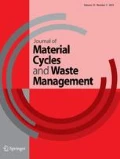Abstract
Organic binders that are used in sand casting emit high amounts of hazardous pollutants and volatile organic compounds during the casting process. Inorganic binders do not emit harmful gases and are widely used in aluminum casting processes. However, there is a paucity of studies on the reuse of waste sand using inorganic binders in casting processes. In the study, waste sands using an inorganic binder and a powder were recycled via wet regeneration and the effects of residual powder on regenerated sand were analyzed. The wet regeneration of molding and casting sands was performed by cleaning, followed by grinding in a 0.2-M KOH solution and then removing the residual binder using water. The molding sand was regenerated to the same level as the raw sand via the 0.2-M KOH solution followed by water cleaning twice. The casting sand removed most of the binder via additional water cleaning for the regeneration condition of the molding sand. Although the powder was completely removed from the regenerated molding sand, the regenerated casting sand remained used powder; the residual powder had a 78% performance. Thus, the regenerated casting sand was reusable only when adding binder without powder.










Similar content being viewed by others
References
Tiedje N, Crepaz R, Eggert T, Bey N (2010) Emission of organic compounds from mould and core binders used for casting iron, aluminium and bronze in sand moulds. J Environ Sci Heal A 45:1866–1876. https://doi.org/10.1080/10934529.2010.520595
Wang Y, Zhang Y, Su L, Li X, Duan L, Wang C, Huang T (2011) Hazardous air pollutant formation from pyrolysis of typical chinese casting materials. Environ Sci Technol 45:6539–6544. https://doi.org/10.1021/es200310p
Cui R, Ma YL (2013) Characteristics of volatile organic compounds (VOCs) emission from electronic products processing and manufacturing factory. Environ Sci 34:4585–4591
Kim KY, Yi MS (1998) Quantitative Prediction of Gas Evolved by Shell Core in Permanent Mold Casting of Aluminum Alloy. J Korean Foundry Soc 18:481–487
Holtzer M, Dańko R, Kmita A (2016) Influence of a reclaimed sand addition to moulding sand with furan resin on its impact on the environment. Water Air Soil Pollut 227:16. https://doi.org/10.1007/s11270-015-2707-9
Bae MA, Kim MH, Park JW, Lee MS (2018) Effect of additives on the sand burning of inorganic binder in al-si7mg alloy casting (in Korean). Korean J Met Mater 56:327–333. https://doi.org/10.3365/KJMM.2018.56.4.327
Shin SS, Kim WC, Kim ES, Lim KM, Park JW (2013) Effects of organic and inorganic binder core on microstructure and mechanical properties of Al casting products (in Korean). J Korean Foundry Soc 33:147–156. https://doi.org/10.7777/jkfs.2013.33.4.147
Joseph MK, Banganayi F, Oyombo D (2017) Moulding sand recycling and reuse in small foundries. Proced Manuf 7:86–91. https://doi.org/10.1016/j.promfg.2016.12.022
Severo JA, Modolo RCE, Moraes CAM, Zinani FCF (2018) Thermal regeneration of waste foundry phenolic sand in a lab scale fluidized bed. Rev Mater. https://doi.org/10.1590/s1517-707620170001.0319
Stachowicz M, Granat K (2016) Influence of wet activation of used inorganic binder on cyclically refreshed water glass moulding sands hardened by microwaves. Chin Foundry 13:427–432. https://doi.org/10.1007/s41230-016-5077-z
Fan Z, Huang N, Wang H, Dong X (2005) Dry reusing and wet reclaiming of used sodium silicate sand. Chin Foundry 2:38–43. https://doi.org/10.1007/s41230-016-5117-8
Wang L, Jiang W, Liu F, Fan Z (2017) Investigation of parameters and mechanism of ultrasound-assisted wet reclamation of waste sodium silicate sands. Int J Cast Met Res 31:169–176. https://doi.org/10.1080/13640461.2017.1405543
Hefei city tenver precision casting co., LTD. (2016) Water glass waste sand regeneration treatment method used for casting. China Patent 201610354783:2
Tianjin Sigma Innova Technology co., LTD. (2014) Method utilizing ultrasonic technology to regenerate used sodium silicate sand. China Patent. 201410632362
Hefei city tenver precision casting co., LTD. (2016) Regeneration treatment method of clay wet type used sand. China Patent 201610354795:5
Yang X, Roonasi P, Holmgren A (2008) A study of sodium silicate in aqueous solution and sorbed by synthetic magnetite using in situ ATR-FTIR spectroscopy. J Colloid Interface Sci 328:41–47. https://doi.org/10.1016/j.jcis.2008.08.061
Ko EY (2020) Chemical regeneration of waste artificial sand with inorganic binder. Pusan National University, master thesis
Ko EY, Kim KH, Baek JH, Hwang IS, Lee MS (2019) Characteristics of the chemical regeneration for used artificial sand according to the pH value of chemical solution (in Korean). 2019 Korea Foundry Society spring meeting P-02
Kim KH, Kang BY, Lee MS (2016) Comparison of binder removal efficiency of waste sand through chemical regeneration (in Korean). 2016 Korean Society of Industrial and Engineering Chemistry Fall Meeting 1P-619
Bae MA, Kim MH, Park JW, Lee MS (2018) Effect of additives on the sand burning of inorganic binder in Al-Si7Mg alloy casting (in Korean). Kor J Met Mater 56:327–333. https://doi.org/10.3365/KJMM.2018.56.4.327
ASTM C1161–02c(2008) e1 (2008) Standard test method for flexural strength of advanced ceramics at ambient temperature. Am Soc Test Mater. https://doi.org/10.1520/C1161-02CR08E01
Bae MA, Lee MS, Baek JH (2020) The effect of the surface energy of water glass on the fluidity of sand. Korean J Met Mater 58:319–325. https://doi.org/10.3365/KJMM.2020.58.5.319
Vasková I, Varga L, Prass I, Dargai V, Conev M, Hrubovcáková M, Bartošová M, Bul’ko B, Demeter P (2020) Examination of behavior from selected foundry sands with alkali silicate-based inorganic binders. Met 10:235. https://doi.org/10.3390/met10020235
Izdebska-Szanda I, Stefański Z, Pezarski F, Szolc M (2009) Effect of additives promoting the formation of lustrous carbon on the knocking out properties of foundry sands with new inorganic binders. Achiev Foundry Eng 9:17–20
Wang J, Fan Z, Wang H, Dong X, Huang N (2006) An improved sodium silicate binder modified by ultra-fine powder materials. Chin Foundry 4:26–30
Acknowledgements
The study was supported by the Technology Innovation Program (20000126 and 10067386) funded by the Ministry of Trade, Industry & Energy (MOTIE, Korea) and Korea Institute of Industrial Technology (KITECH) through the Research and Development (KITECH EO-20-0140) Grant.
Author information
Authors and Affiliations
Corresponding authors
Additional information
Publisher's Note
Springer Nature remains neutral with regard to jurisdictional claims in published maps and institutional affiliations.
Rights and permissions
About this article
Cite this article
Kim, K.H., Bae, M.A., Lee, M.S. et al. Regeneration of used sand with sodium silicate binder by wet method and their core manufacturing. J Mater Cycles Waste Manag 23, 121–129 (2021). https://doi.org/10.1007/s10163-020-01103-5
Received:
Accepted:
Published:
Issue Date:
DOI: https://doi.org/10.1007/s10163-020-01103-5




